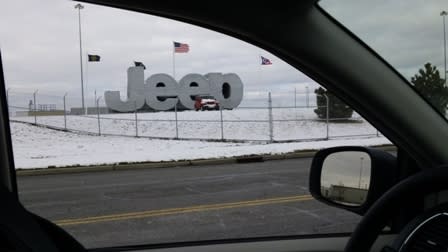 The Ticket
The TicketAs Ohio heads to polls, incumbents point to Toledo as economic poster child
TOLEDO, Ohio—"It's fun again," said Joe Choate, manager of the sprawling General Motors auto parts plant in this city of 287,000 on the shores of Lake Erie.
Near death in 2009, when GM filed for bankruptcy, the plant went down to a skeleton crew of about 15 employees. Last May, GM announced it would invest $200 million in the plant, which is now pumping out 5,200 transmissions per day. More than 2,000 workers are busy making front-wheel drive transmissions for the high-selling Chevrolet Cruze and rear-wheel transmission for pickup trucks and SUVs. "We brought all of our people that we had laid off, brought 250 other people in from GM sites," said Choate. "And now we're just bringing in new Social Security numbers"—that is, new hires.
The workers are feeling better, too. "There is an optimism that we see as a membership and a workforce, that maybe we've turned the corner to some extent," said Ray Wood, president of United Auto Workers Local 14. "You go up to home Depot or Lowe's, or Ideal Hot Dog, or Tom's Tires, and they're talking about the resurgence of this plant." That may be because GM workers last week received profit-sharing bonuses of about $7,000 each.
For a century, Toledo has been tied to the fortunes of the automobile and glass industries. Beset by the usual Rust Belt ills—rising poverty, aging population, a vanishing industrial base, and a deep manufacturing recession—Toledo saw its unemployment rate spike to 13.4 percent in January 2010. Between November 2007 and January 2010, the area lost 42,000 jobs, 12.7 percent of its total. But in the past two years, the local auto industry, anchored by the GM transmission plant and a larger Chrysler Jeep complex, has returned. Car parts suppliers are adding capacity and workers. A deep heritage in glass manufacturing has lead to a boomlet in solar companies. In the second half of 2011, the unemployment rate fell from 10.2 percent to 8.6 percent. Since the nadir, Toledo has added 17,000 jobs.
Today, voters in Toledo are going to the polls to vote in both a contentious Republican presidential primary and a Congressional primary. The districts of two Democratic stalwarts, Marcy Kaptur, based in Toledo, and Dennis Kucinich, based in Cleveland, have been mashed together. Samuel Wurzelbacher, better known as "Joe the Plumber," is running for the Republican nod. And the question today, and for November, is whether this halfway recovery in this vital area in a vital state is enough to bolster the election prospects for incumbents.
This combination of reviving old industry, investing in new technology, and tapping into foreign investment encapsulates the forces that have spurred the unsatisfying recovery since 2009. To a large degree, Toledo is a test case for some of Obama's policies — specifically the auto bailout. "If you're sitting in Toledo, this has affected you and your family in a positive way," says Michael Bell, the former University of Toledo football star and longtime fire chief who was elected mayor as an independent in 2009. "But we've got a ways to go."
The rapid bounce-back in auto sales and production has helped fuel the local economy—and not just as the GM plant. In this age of lean manufacturing, warehousing, trucking, parts and logistics, companies rely on demand for finished vehicles. This week the Toledo Business Journal leads with news that GROB Systems, a subsidiary of a German company that makes auto components, is expanding its factory in nearby Bluffton, which will create 113 new positions. Both GM and Chrysler have recently paid out profit-sharing bonuses to employees. "A lot of our membership are taking their bonuses and buying washers, refrigerators, cars, or helping out with tuition," says Roy Wood of the UAW.
The heightened focus on energy and fuel efficiency in the economy is paying dividends in Toledo. Innovation in transmissions can help bolster vehicle mileage, which is one of the reasons GM is investing so much in the local plant. The GM factory has also inked a deal with a Toledo-based firm, Solscient Energy, to install solar arrays on its roof with a capacity of 1.8 megawatts—about one-tenth of the factory's energy consumption. Unlikely as it may seem for a cloudy city on Lake Erie, solar electricity is a significant industry cluster here. The region's glassmakers have applied their expertise to solar panels, and research from the University of Toledo helped create the large panel maker First Solar, which is now based in Arizona.
In a business incubator at the University of Toledo, I met Bruce Larsen, a former Owens-Illinois executive who is chairman and CEO of Nextronex. Nextronex, backed by two local venture capital funds, was started in 2009, at the depths of the recession. It makes inverters, the devices that convert energy produced on panels into alternating currents that help maximize the flow of energy in low light level conditions — that is, during cloudy periods or in the early morning. Doing so can effectively increase the output of a typical array in the Midwest by up to eight percent. Last year, Nextronex completed eight projects, mostly in Ohio, including a 2.2-megawatt system in the town of Bryan. The company has 12 employees. But because it relies almost exclusively on local suppliers, it supports another 24 positions in the region. Nextronex expects sales will more than double in 2012, to about $5 million.
In many ways, Toledo has a highly localized and parochial economy. A sign in the UAW's parking lot warns that foreign-produced cars are not welcome. But spend some time here and you'll quickly realize how much Toledo is connected to the global economy. In front of the Chrysler plant, there's a huge JEEP sign backed by large American flags. But a German flag flies in the Chrysler Supplier Park. Why? A German firm, Kuka, makes the bodies for the Wrangler, while Mobis, owned by Hyundai, makes the chassis. And of course, the whole company is now owned by an Italian firm, Fiat.
Wrangler sales powered through 2009. A production schedule of 170,000 for this year has employees working on two shifts, 10 hours a day, six days a week. Last November, Fiat CEO Sergio Marchionne announced the company would invest $1.1 billion and hire 1,100 workers at a second Chrysler plant here to produce a new SUV based on Fiat architecture that will replace the Jeep Liberty. Workers are already erecting the 335,000 square-foot addition. Last month Johnson Controls said its Northwood plant would make seats and instrument panels for the new Fiat-based Jeep.
Italy isn't the only unlikely source of support. Mayor Bell, a Harley-driving African American who sports a white-flecked beard and cowboy boots, has been to China three times since his election, hitting major cities like Beijing and Shanghai, and singing the virtues of Toledo. Last year, a Chinese company, Dashing Pacific, paid $3.8 million for a 69-acre plot of land on the east side of the Maumee River that has seen several development schemes come and go. In time, city officials expect the Chinese firm to construct a mixed-use project worth between $200 million and $300 million.
How is this playing out in the campaign? Toledo has seen its share of candidates. President Obama visited the Chrysler plant recently. Mitt Romney was here last week. Ironically, the GOP candidates frequently seem to be on the wrong side of the trends that are spurring growth in Toledo: the revival of auto manufacturing, green energy, and a more intense engagement with China. Marcy Kaptur, the popular Democratic Congresswoman, is also a consistent critic of China. But there's a realization here that the trends and forces impacting the economy are more complicated than campaign sound bites.
For the longest time, U.S.-based automakers seemed to be victims of trends in the global economy. In Toledo, at least, they seem to be beneficiaries. Marchionne has said he wants to export Wranglers from Toledo to Europe. The General Motors plant produces the eAssist, the new hybrid-lite transmission system that is now the standard base package for the new Malibu. That is becoming an export too. Said Joe Choate of General Motors: "We're shipping some to a joint venture in Korea, and it also goes into a Chevrolet badge in South America."
Daniel Gross is economics editor at Yahoo! Finance. Follow him on Twitter @grossdm; email him at grossdaniel11@yahoo.com. His book, "Better, Stronger, Faster: The Myth of American Economic Decline" will be available in early May.
Read more coverage of Super Tuesday 2012 at Yahoo! News.
More popular Yahoo! News stories:
• Romney is 'very good at deceiving voters,' Gingrich spokesman says
• Obama, appearing with Netanyahu, sees 'difficult months' ahead in Iran standoff
• Romney hoping for a 'reset' among voters, after a long and heated primary
Want more of our best political stories? Visit The Ticket or connect with us on Facebook, follow us on Twitter, or add us on Tumblr. Handy with a camera? Join our Election 2012 Flickr group to submit your photos of the campaign in action.



